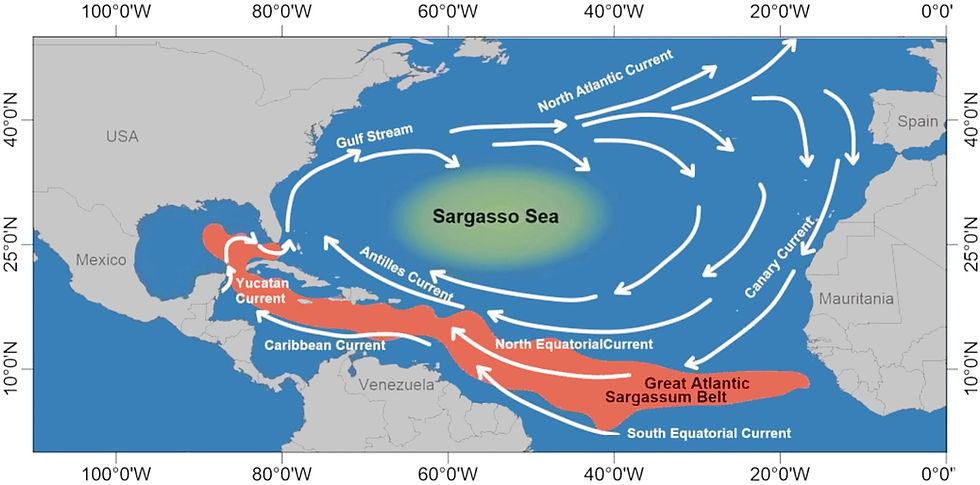The Sargassum Crisis in the Caribbean: San Blas Beaches Stay Clear All Year
- Matt

- Sep 13
- 3 min read
Updated: Sep 15
While sargassum invades Caribbean shores, San Blas, Panama remains pristine and sargassum-free year-round, offering crystal-clear beaches and waters
Over the last decade, the Caribbean has been hit by an escalating crisis: sargassum blooms. What was once a natural seaweed that nourished marine life has turned into an environmental menace—a nightmare for Caribbean destinations from Puerto Rico to the Guyanas, including the Yucatán and Dominican Republic, causing escalating ecological, economic, and tourism problems.

Since 2011, warming oceans, nutrient runoff from rivers like the Amazon, and shifting currents have fueled unprecedented growth. That same year, the Great Atlantic Sargassum Belt appeared—stretching from West Africa to the Caribbean and Gulf of Mexico—bringing with it massive, recurring coastal invasions that show no sign of slowing down.
San Blas, Panama, however, remains a rare exception. Its beaches stay clear and pristine all year, offering travelers a Caribbean paradise untouched by the sargassum crisis.

What Is Sargassum and Where Does It Come From?
Sargassum is a brown, free-floating algae historically associated with the Sargasso Sea, a region of the North Atlantic. In small amounts, it plays a positive ecological role, offering shelter and food for fish, turtles, and seabirds.
But since 2011, the situation has changed dramatically. Rising ocean temperatures, nutrient-rich runoff from rivers such as the Amazon, and shifting currents have fueled explosive growth in sargassum quantities. Scientists now identify this phenomenon as the Great Atlantic Sargassum Belt—a vast, seasonal accumulation of seaweed that stretches from the coast of West Africa, across the tropical Atlantic, and into the Caribbean and Gulf of Mexico.

This new reality has transformed sargassum from a natural ally of marine life into one of the most disruptive environmental challenges facing the Caribbean today.

The Economic Toll Across the Caribbean
For many islands, tourism is the main source of income, and sargassum has turned idyllic white-sand beaches into unappealing, foul-smelling shorelines. When massive mats of sargassum wash ashore, they release toxic hydrogen sulfide gas—known to irritate the eyes, nose, and throat, and aggravate respiratory conditions. Outbreaks have even prompted evacuations and health alerts in places like Guadeloupe.
Resorts, hotels, and local economies have suffered billions in losses due to canceled trips, costly cleanup operations, and declining visitor satisfaction. Countries such as Mexico, the Dominican Republic, and Jamaica are struggling every year to manage this growing environmental crisis.
The economic consequences are staggering:
The Caribbean endured $102 million in losses in 2022 alone, excluding additional expenses for beach cleanups (est. up to another $210 million)
2018 cleanup costs across the region totaled $120 million, with Miami-Dade County (U.S.) spending $35 million annually
These blooms harm tourism, fisheries, and local livelihoods, erode beaches, shut down businesses, and degrade public health
Why San Blas, Panama, Is Different: A Natural Refuge from the Sargassum Invasion
While much of the Caribbean struggles with sargassum, San Blas (Guna Yala), Panama, remains completely free of it. Thanks to its privileged geographic location in the southwestern Caribbean, ocean currents naturally bypass the San Blas archipelago. This means its beaches and turquoise waters stay pristine all year round.

Even more, San Blas lies outside the hurricane belt, making it one of the few places in the Caribbean where travelers can enjoy safe, calm, and crystal-clear waters no matter the season. For those seeking a true paradise untouched by the sargassum crisis, San Blas offers what other destinations can no longer guarantee:
Unspoiled beaches free of sargassum.
Year-round sailing with no hurricane risk.
A unique cultural experience with the Guna people in a setting that remains authentic and natural.

San Blas: the Caribbean Paradise You Can Always Count On
The sargassum crisis is reshaping the Caribbean, creating challenges for tourism and local economies that will likely continue for decades. While solutions are on the horizon, many destinations are still struggling to adapt.
San Blas, however, stands apart as a rare sanctuary in the Caribbean—free of sargassum, free of hurricanes, and full of natural beauty and cultural richness.
For travelers seeking a truly pristine Caribbean escape, San Blas is not just an alternative—it’s the future of paradise travel.



Comments